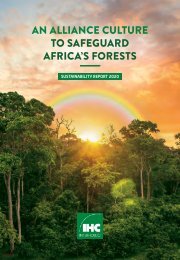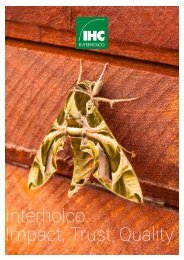Nomenclature Générale des Bois Tropicaux - 7ème édition
(english description below) Cette nomenclature est utilisée pour la mise à jour du 'Harmonized Code System' de l’Organisation Mondiale des Douanes. Dans la circulaire du 5 avril 2005, le Ministère de l’Economie, des Finances et de l’Industrie (France) reconnaît l’ATIBT comme « gardien du temple » de la nomenclature des bois tropicaux. La Commission Européenne mentionne la nomenclature de l’ATIBT comme document de référence pour la mise en œuvre du RBUE. Depuis 1954, l’ATIBT a établi et mis à jour une nomenclature des bois tropicaux faisant correspondre chaque espèce botanique avec un nom pilote reconnu internationalement. La détermination du nom pilote d’une essence est cruciale, car sa commercialisation dépend très largement de l’adoption de ce nom par le public. Le nom pilote assure la protection de l’appellation commerciale de l’essence et l’intégrité des propriétés qui lui sont attribuées, sans risque de confusion. The 1982 version of the general timber nomenclature has finally been updated as some of the 1,750 identified species, are no longer traded, while others, which were not previously included, are now on the market. The present revision has also integrated changes related to new taxonomy, in order to reflect the latest scientific developments. This Nomenclature has been used for the Harmonized Code System, updated by the World Customs Organization. The French Ministry of economy, finance and industry has given official recognition to ATIBT as the reference for the tropical timber nomenclature (NOR: PRMX0508285C of April 5th 2005). The European Commission refers to ATIBT nomenclature as a reference document for the implementation of the EUTR regulation. Since 1954, ATIBT has established and updated a nomenclature of tropical wood, linking each botanical species with an internationally recognized pilot name. A sigle wood species may have many common names; when trading across different countries, this may lead to confusion. Fixing the pilot name of a timber species is crucial, to protect the commercial denomination of the species and guarantee the veracity of the properties linked to that species, without confusion.
(english description below)
Cette nomenclature est utilisée pour la mise à jour du 'Harmonized Code System' de l’Organisation Mondiale des Douanes. Dans la circulaire du 5 avril 2005, le Ministère de l’Economie, des Finances et de l’Industrie (France) reconnaît l’ATIBT comme « gardien du temple » de la nomenclature des bois tropicaux. La Commission Européenne mentionne la nomenclature de l’ATIBT comme document de référence pour la mise en œuvre du RBUE.
Depuis 1954, l’ATIBT a établi et mis à jour une nomenclature des bois tropicaux faisant correspondre chaque espèce botanique avec un nom pilote reconnu internationalement. La détermination du nom pilote d’une essence est cruciale, car sa commercialisation dépend très largement de l’adoption de ce nom par le public. Le nom pilote assure la protection de l’appellation commerciale de l’essence et l’intégrité des propriétés qui lui sont attribuées, sans risque de confusion.
The 1982 version of the general timber nomenclature has finally been updated as some of the 1,750 identified species, are no longer traded, while others, which were not previously included, are now on the market. The present revision has also integrated changes related to new taxonomy, in order to reflect the latest scientific developments.
This Nomenclature has been used for the Harmonized Code System, updated by the World Customs Organization. The French Ministry of economy, finance and industry has given official recognition to ATIBT as the reference for the tropical timber nomenclature (NOR: PRMX0508285C of April 5th 2005). The European Commission refers to ATIBT nomenclature as a reference document for the implementation of the EUTR regulation.
Since 1954, ATIBT has established and updated a nomenclature of tropical wood, linking each botanical species with an internationally recognized pilot name. A sigle wood species may have many common names; when trading across different countries, this may lead to confusion. Fixing the pilot name of a timber species is crucial, to protect the commercial denomination of the species and guarantee the veracity of the properties linked to that species, without confusion.
Create successful ePaper yourself
Turn your PDF publications into a flip-book with our unique Google optimized e-Paper software.
54 ///
Nomenclature générale des bois tropicaux 2016
PILOT NAME BOTANICAL NAMES COMMON NAMES
Balsa
Balsamo
Banga-Wanga
Bangkal
Baromalli
Basralocus
Batai
Batete
Batibatra
Batino
Bayur
Ochroma pyramidale Urb.
(Syn. Ochroma lagopus)
Myroxylon balsamum Harms
(Syn. Myroxylon toluiferum)
Myroxylon peruiferum L.
Amblygonocarpus andongensis Exell &
Torre
(Syn. Amblygonocarpus obtusangulus)
Nauclea officinalis L.
Nauclea orientalis L.
Nauclea spp.
Neonauclea calycina Merr.
Neonauclea excelsa Merr.
Neonauclea lanceolata Merr.
Neonauclea spp.
Catostemma commune Sandw.
Catostemma fragans Benth.
Catostemma sclerophyllum Ducke
Catostemma spp.
Dicorynia guianensis Amsh.
Dicorynia paraensis Benth.
Falcataria moluccana Bernaby & J.W.
Grimes
(Syn. Paraserianthes falcataria)
Kingiodendron alternifolium Merr &
Rolfe
Enterolobium schomburgkii Benth.
Alstonia macrophylla Wall.
Alstonia spectabilis R. Br.
Alstonia p.p. (AS)
Pterospermum acerifolium Willd.
Pterospermum diversifolium Blume
Pterospermum javanicum Jungh.
Pterospermum spp.
Algodon (SV) ; Balsa (EC, HN, PE) ; Balso (VE) ;
Bois Flot (TT) ; Catillo (NI) ; Guano (BZ, HN) ;
Lanilla (GT) ; Lanu (CO) ; Palo de Balsa (PE) ; Pau
de Balsa (BR) ; Tami (BO) ; Topa (PE)
Arbol del Bálsamo (MX) ; Balsam (BE) ; Balsamo
(HN) ; Bálsamo (MX) ; Bálsamo de Perú (PE) ;
Bálsamo de Tolu (PE) ; Cabreuva vermelha (BR) ;
Estoraque (PE) Incienso (AR, PY) ; Myroxylon (CO) ;
Oleo vermelho (BR) ; Quina-quina (AR, PE) ; Sandalo
(EC)
Banga-Wanga (MZ) ; Mécuria (MZ) ; Mutiria (MZ) ;
Muwaka (MZ)
Bangkal (MY) ; Câi-gao (VN) ; Kanluang (TH)
Arenillo (PE) ; Baramalli (GY) ; Baraman (VE) ;
Baramanni (VE) ; Baromalli (GY) ; Barrigudo (BR) ;
Bonga (PA) ; Flambeau rouge (GF) ; Kajoewaballi
(GY) ; Macondo (CO) ; Orogoguei (CO)
Angelica (BR) ; Angélique (GF) ; Barakaroeballi (SR) ;
Basralocus (GY) ; Basralokus (SR) ; Tapaiuna (BR)
Jeungjing (ID) ; Moluccan Sau (PH) ; Batai (MY) ;
Falcata (PH) ; Kayu Machis (MY) ; Puah (MY) ; Sengon
Laut (ID) ; Sikat (ID)
Batete (PH)
Acacia franc (GF) ; Batibatra (BR) ; Bougou Bati Batra
(GF) ; Fava de Rosca (BR) ; Fava Orelha de macaco
(BR) ; Fava Orelha de negro (BR); Genizero (BR) ;
Tamaren Prokoni (SR)
Ai wawoi (PG) ; Andelagar (PG) ; Barakir (PH) ; Batino
(ID, PG, PH) ; Dalakan (PH) ; Dero (PG) ; Kai
Riti (ID) ; Koanan (PG) ; Kra Thungfa Hai (TH) ;
Pulai Daun Besar (MY) ; Pulai Penipu Bukit (MY) ;
Pule Batu (ID) ; Sayongan (MY) ; Teen Thian (TH) ;
Thungfa (TH)
Bayur (MY) ; Lang-Mang (VN)
Bedaru Cantleya corniculata Howard Bedaru (ID) ; Daru (MY) ; Dedaru (MY)
Beech, White Gmelina moluccana Baker White Beech (PG, SB)
Beefwood
Benuang
Casuarina cunninghamiana Miq.
Casuarina equisetifolia L.
Casuarina junghuhniana Miq.
Casuarina spp.
Octomeles sumatrana Miq.
Agoho (PH) ; Beefwood (AU) ; Casuarina (AU) ; Filao
(PF)
Benuang (ID, MY) ; Binuang Bini (ID) ; Erima (PG) ;
Ilimo (PG) ; Irima (PG) ; Libas (PH) ; Winuang (ID)














